 |
| March 10, 2015 | Volume 11 Issue 10 |
Designfax weekly eMagazine
Archives
Partners
Manufacturing Center
Product Spotlight
Modern Applications News
Metalworking Ideas For
Today's Job Shops
Tooling and Production
Strategies for large
metalworking plants
Engineer's Toolbox:
Solving the manufacturing equation for metal parts
By Gus Breiland, Customer Service Engineering Manager, Proto Labs
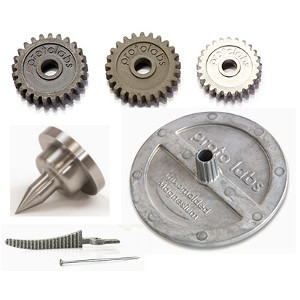
Proto Labs now produces metal parts using both additive and subtractive processes, the number of offerings continue to multiply, and metal parts are being produced by all three of our divisions. With metal injection molding (MIM), magnesium thixomolding, three-axis milling and turning, and direct metal laser sintering (DMLS), the challenge becomes how to create the right manufacturing equation that best works for your product. Each has its strengths, and depending on your needs, chances are that you may use more than one process during the development of your product.
Metal injection molding
Our MIM process is similar in many ways to plastic injection molding and, in fact, uses thermoplastic as a carrier (binder) for the finely divided nickel steel or stainless steel particles that will form the final part.
As in rapid plastic injection molding, a mold is designed and milled based on the customer's 3D CAD model. A feedstock, consisting of a mix of thermoplastic binder and metal particles, is injected into the mold to produce a green part. That part is transferred to a debind oven that removes most of the thermoplastic, leaving metal and a small amount of binder that holds the metal particles together. This resulting brown part is porous, brittle, and larger by a carefully calculated percentage than the original design. It is placed in a sintering oven where, at a temperature of 2,900 deg F, the remaining binder burns off, the metal particles sinter together, and the part shrinks by about 20 percent to form a solid in the shape and size of the original design.
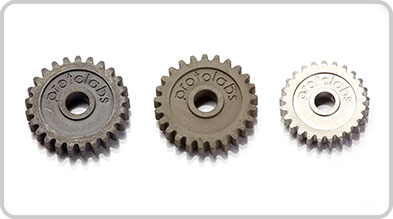
A MIM part goes through a multi-stage debind and sintering process before arriving at its final state.
The finished part is 97 to 99 percent as dense as solid metal and can be finished by heat treatment, by machining, or by coining, a stamping process that causes the metal at the surface of the part to flow to a desired area. Tumbling and/or bead blasting as an optional secondary process is often used to improve the surface finish. MIM is widely used for producing relatively simple small parts for industries like medical, aerospace, or firearms.
MIM can produce metal parts up to 4 in. by 4 in. by 4 in. (101 mm by 101 mm by 101 mm), or about the size of a tennis ball. It has many of the same capabilities as our plastic injection molding process, such as the ability to use side actions to reproduce undercut features. And while traditional MIM only becomes cost effective at volumes of 30,000 pieces or more, our MIM process can be used for volumes as low as 25 parts while remaining competitive as quantities rise into the thousands. Proto Labs currently stocks stainless steel (Catamold 316L and 17-4 PH) and nickel steel (Catamold FN02) for MIM, with chrome-moly steel (Catamold 42CrMo4) to follow in the near future.
Magnesium thixomolding
Thixomolding is a specialized process for making parts out of magnesium. It produces fully dense parts by injecting a gel-like slurry of chipped magnesium into a steel mold under high pressure and allowing the material to cool and solidify. It produces net shape parts that are very true to the CAD models from which molds are made.
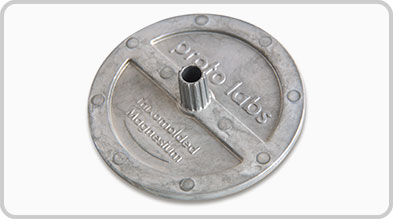
Thixomolding produces net-shape magnesium parts that are lightweight and strong.
They are affordable, strong, light, and similar to parts produced by magnesium die casting, but they can have thinner walls, finer detail, and less surface porosity. Proto Labs' process is cost-effective for volumes of 25 to 5,000 parts. Maximum part size limits at this time are approximately 9 in. by 11.5 in. by 4 in. (228 mm by 292 mm by 101 mm), and smaller if side-actions are required. Proto Labs currently stocks Magnesium AZ-91D for thixomolding.
CNC machining
Our machining service has been producing low-volume machined metal parts direct from 3D CAD models for several years. The process is ideal for small quantities because the high overhead of manual setup is eliminated using sophisticated software that turns a 3D CAD model directly into toolpaths for the machining equipment to follow. On the other hand, there is little economy of scale -- as the number of parts increases, the cost advantage over low-volume production methods such as MIM decreases.
Parts that are machined using three-axis milling can be as small as 0.25 in. by 0.25 in. by 0.25 in. (6.35 mm by 6.35 mm by 6.35 mm) with a maximum part size of 10 in. by 7 in. by 3.75 in. (254 mm by 178 mm by 95 mm), which is significantly larger than what MIM parts can achieve. Milled parts can be machined from more than 30 materials including aluminum, brass, copper, and magnesium as well as various steel and stainless steel alloys (and various plastics, of course). Because parts are machined from solid plate stock, they can have better tensile strength than parts made of similar material using other processes. Good finishes can be achieved without secondary processes, and turnaround can be very fast.
Additionally, we will be soon be launching our new lathe service for qualified metal parts. Our CNC lathes rapidly turn parts out of rod stock in a subtractive turning process with additional live tooling. We employ live tooling so features like flats, grooves, and slots can be machined as well as off-axis and radial holes. Turned parts can then be left as-machined, with visible tool marks, or bead blasted. Turning is ideal for cylindrical metal parts. Initial metals include aluminum, stainless steel, steel alloy, and mild low-carbon steel, with more materials to be added later in 2015. Because round rod stock is used in turning versus the plate stock used in machining, the available part size differs. Turned parts have a maximum part diameter of 2.95 in. (75 mm) and a maximum length of 9.0 in. (228 mm). Look for lathe on your quotes in early 2015.
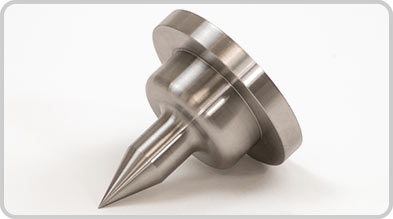
Turning with live tooling allows for a combination of cylindrical and milled features on metal parts.
Direct metal laser sintering
DMLS is an additive process that rapidly sinters metal powder into a final part. Like all of Proto Labs' processes, DMLS begins with a 3D CAD model. Proprietary software digitally slices the model into thousands of thin layers, and a laser system traces the design onto a fine layer of powdered metal, sintering the powder. The process is repeated layer by layer to produce a finished metal part. DMLS produces parts with a density of 99 percent or greater, with comparable strength to parts machined from solid metal stock. As-sintered part surfaces are not as smooth as machined parts. Designs can be built from a number of different metals including aluminum (AlSi10Mg), cobalt chrome, Inconel (718), stainless steel (17-4PH and 316L), and titanium (Ti 6-4).
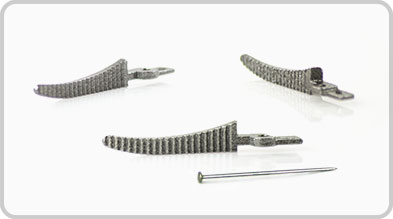
DMLS parts can be built in small sizes, with complex geometries and from various engineering-grade metals.
Our DMLS process can make parts up to 9.8 in. by 9.8 in. by 11 in. (248 mm by 248 mm by 279 mm) in normal resolution (layer thickness of 0.0012in./30 microns) and 3.5 in. by 3.5 in. by 2.9 in. (88 mm by 88 mm by 73 mm) in high resolution (layer thickness of 0.0008in/20 microns). Like many 3D-printing technologies, DMLS can also support features that cannot be produced by any other machining or molding technology, such as internal holes and channels. Like machining, the cost at low volumes is very competitive for small quantities, one-off parts, and jigs and fixtures. The process can also be used to produce larger volumes of complex parts that cannot be made using other processes. DMLS technology is relatively new and is being developed quickly; watch for tremendous growth in its capabilities.
Solving the equation
Choosing among the available metal-forming technologies can be a complicated process. Magnesium, for example, can be formed either by machining or by thixomolding. The former would be the most cost-effective process for low volumes, the latter for higher volumes. For very small numbers of parts in a variety of engineering-grade materials, machining is a good choice. If, however, the parts have features that cannot be produced by three-axis milling or turning, DMLS would be a better approach. If you want low-cost steel parts in larger numbers, MIM is an excellent choice.
Please contact one of our Customer Service Engineers at 877.479.3680 or customerservice@protolabs.com with any questions. They'll be able to guide you towards a metal manufacturing process that works best for your design and budget. For immediate pricing information and free design analysis on your part, upload your 3D CAD model for a quote within hours.
Published March 2015
Rate this article
View our terms of use and privacy policy
